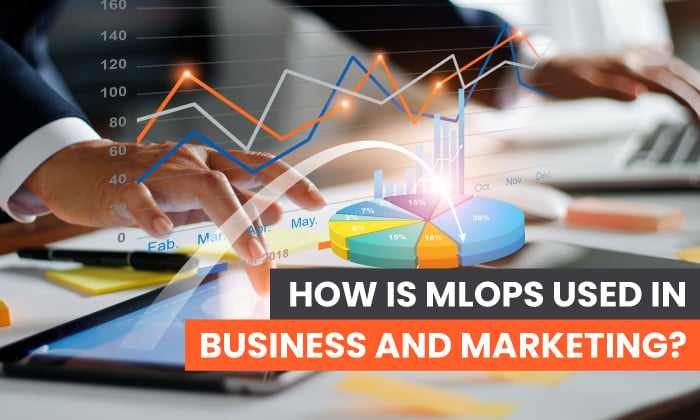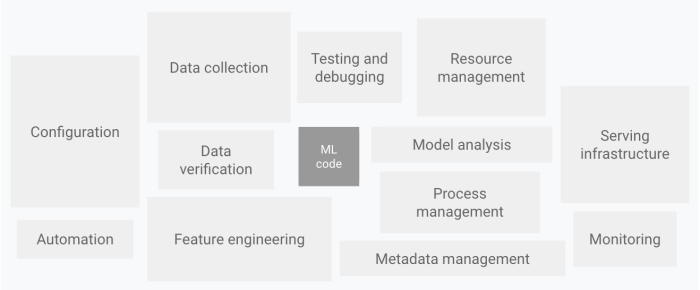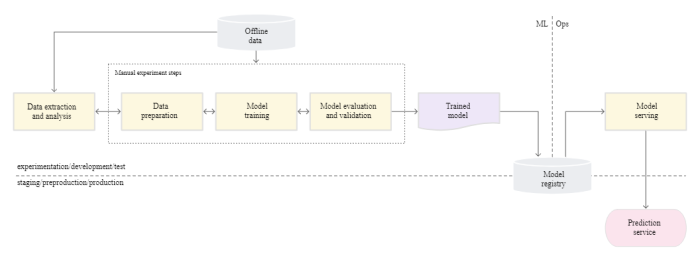
Chances are, your brand has data scientists and operations professionals on the team, and while they do their best to collaborate, they each have their own areas of expertise.
This could lead to miscommunications and misunderstandings. The data scientists can interpret the data, but they likely don’t have the background to manage business operations. Likewise, the business team can make their side of things work, but they don’t fully know how to interpret and implement data.
Here is where machine learning operations (MLOps) come in.
In this article, we’ll discuss how MLOps can help with collaboration between your data and business teams, as well as additional immediate and future benefits of implementing it.
What is MLOps?
MLOps, in simple terms, is a set of best practices for improving communication and collaboration between your employees on the data science and operations sides of your brand.
In less simple terms, it’s a combination of machine learning, data engineering, and development operations. The goal is to provide a more streamlined process for developing and creating machine learning systems, allowing business administrators, data scientists, marketers, and IT engineers to cooperate on the same level.
It is an extension of what we know as DevOps. DevOps is the process of organizing cooperation between everyone involved in the design and building of big data. This process has been around for a while, but MLOps is still in its youth.
MLOps creates a lifecycle and a set of practices that apply to the development of machine learning systems. This includes research, development, operations, and implementation.

The process of brainstorming, developing, and implementing machine learning is extensive. Having a set of duplicatable processes to guide each project helps in many ways.
5 Benefits of MLOps
Now that we have a general understanding of MLOps, let’s look at how it can impact our businesses. All new technology has either a positive or negative effect on the digital marketing industry, so it’s crucial we understand what we’re getting.
1. MLOps Can Increase Efficiency and Automation
Making the most of our time is something most of us strive to do.
Ironically, we spend a lot of time figuring out how to do this.
We may look into all different kinds of apps and books. We could spend days reading articles or even attending seminars on efficiency and time management.
But, perhaps automating would be simpler for many people.
Automation, by definition, should increase efficiency. Once minute tasks are out of people’s hands, they can focus on big picture issues.
An essential but draining task many folks on data science teams spend time doing is data entry. That’s time they could spend focusing on the science rather than passively improving their typing skills (and, we all know, a typo in data entry can bring disaster!).
MLOps gives options for automating tasks like data entry. It takes some work upfront, but once things are going, the data scientists can get back to what they do best.
2. MLOps Eliminates Waste
MLOps helps businesses improve communication and avoid bottlenecks and costly errors.
How much time have you wasted answering the same questions, reiterating a previous point, or working extra hours to clean up an error because someone simply didn’t know what to do—or what someone else was supposed to be doing?
If you had a set of operations for each employee or contractor to follow, there would be no need to answer the same question continually. You could send them an operations checklist, and they work through it until completion.
The best thing about this is it’s highly duplicatable. I’ll use the example of a content marketing company creating content for its clients.
Let’s say you run a site reviewing camping products. Every page should follow the same basic format so your readers can easily compare products or skim to the parts they care about most.
Suppose you give your reviewers and editors a template to follow, step-by-step instructions, and information about what the others are doing. In that case, confusion can be lessened, and you can focus on which hiking boots are best in winter weather.
MLOps does this, not for content, but for communication. It allows leaders to share “templates” of what should be done on a given day and, after any frontloading, questions should lessen and related waste eliminated.
3. MLOps Focuses on Collaboration
As mentioned, a lack of communication can kill a business quickly. Collaboration between departments is so crucial. Otherwise, work gets lost, notes aren’t passed on, things get missed—and tempers may flare.
MLOps creates procedures for passing one task on to another department. The word “lifecycle” is often used to describe this process.
As a project moves through the lifecycle, workers should be able to see what has happened, what should be happening now, and what will happen next.
This is where we put on our marketer hat and look towards tools like ClickUp and Trello. These are useful for managing large numbers of tasks at the same time.
People involved in the project can access things like checklists and previous conversations at all points in the pipeline, eliminating the wait for responses on work chats or dealing with the dreaded group email.
Communications come in order, everyone who needs to be in on the conversation can be, and they’re unlikely to get lost in dozens of messages.
This process also allows for documentation. Not only does this create a paper trail of who did what so the right people can be given feedback, but it also eliminates miscommunication because it’s all outlined already.
4. MLOps Supports Machine Learning Models

Reducing the amount of variation from one project to another is an important key to scaling any business. MLOps help do this by creating reproducible models you can use as a benchmark at the beginning of each new project.
These data set registries help track resources, project data, logs, and metrics. These factors combined eliminate bottlenecks, reduce wasted time, and help move projects through the pipeline faster.
Essentially what you’re doing is creating a template that can be used over and over. These machine learning “templates” or “models” help reduce production time and produce a better product by having a benchmark to follow each time a new machine learning model comes out.
Having a duplicatable model is vital in marketing because it allows you to input any variable and experience the same result. SEO is an exceptional example of this.
Once you have a proven strategy to create content, upload it, optimize it, drive links to it, and re-optimize, you’ll never have to worry about variables because the steps are the same.
It wouldn’t matter if you were ranking an article about ergonomic keyboards or funeral home carpeting because the bones are the same.
It starts with providing those in need with the resources they want on their own time. We live in a 24-7 connected world where people work all different kinds of hours.
Gone are the days of working 9-5 and leaving all your work behind. Every employee or contractor you have should be able to receive an answer to any question when they need it.
If they have to sit around and wait for you to come back into the office in the morning, it’s creating a bottleneck, slowing down your process, and ultimately costing you money.
5. MLOps Makes Deployment and Implementation Easier
MLOps’ ability to improve communication, create processes, and automate things can make deployment and implementation easier because of the inherently reduced chances of errors.
With MLOps at their fingertips, developers can pack models much faster while still maintaining quality control with profiling and model validation.
It provides a way for data scientists and administrators to perform at a higher level with confidence in knowing each step was followed and validated for consistency.
What is the Future of MLOps in Business and Marketing?
MLOps is a new but colossal industry expected to hit $4 billion by 2025. The most significant impact it may have relates to how we manage data.
Data is meaningless if you don’t have an understandable way to translate it.
Machine learning operations allow you to take that data and turn it into something tangible. For example, if you made some changes to a specific business model and you notice worsening results after six months, you may want to circle back to the original model.
Plus, MLOps provides consistency. Producing a consistent product is a tall order because each scenario is different, and you’ll likely run into unique issues each time. Businesses all over the world struggle to put out a consistent product/service time and time again.
MLOps helps data scientists and operations managers work together to produce consistent results across a considerable time frame. As the project moves from one end of the pipeline to another, all the people involved need to have a way to ensure quality is maintained. MLOps can even automate the process of quality assurance with routine scans.
Conclusion
MLOps helps create lines of communication between everyone involved in the process of developing machine learning technology. As marketers, we can learn something from this and implement the same principles in our businesses.
Every business can benefit from clear guidelines and processes to follow. If you’re experiencing bottlenecks, slow production times, and a large number of errors, you might want to pull back the curtain and take a look at your procedures as a whole.
If that sounds like a lot of work, we can help!
How do you think MLOps will impact business and marketing?
The post How is MLOps Used in Business and Marketing? appeared first on Neil Patel.
from Blog – Neil Patel https://ift.tt/3km2ZSl

No comments:
Post a Comment